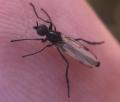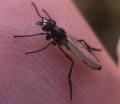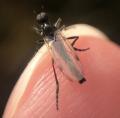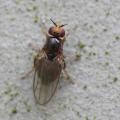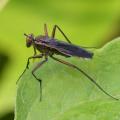|
Users Online
· Guests Online: 6
· Members Online: 0
· Total Members: 4,958
· Newest Member: Mikidebrouwer
Forum Threads
Theme Switcher
Last Seen Users
Latest Photo Additions
|
Paul Beuk's Book Reviews
| BACK | 
Click for full size |  De Nederlandse zweefvliegen (Diptera: Syrphidae) De Nederlandse zweefvliegen (Diptera: Syrphidae)
[ Category: Ecology and faunistics · Views: 32767 · Comments: 1 ] | | Author | M Reemer, WM. Reemer, W. Renema, W. van Steenis, Th. Zeegers, A. Barendregt, J.T. Smit, M.P. van Veen, J. van Steenis & L.J.J.M. van der Leij | | Language | Dutch  | | Published | 2009 | | Content | This book is the culmination of the so-called Hoverfly Project, which was started in 1999 as a joint initiative of the European Invertebrate Survey – Netherlands, the Diptera Section of the Netherlands Entomological Society and the Dutch Youth League for Nature Observation (NJN). The aim was to create a complete picture of the distribution and ecology of all species of Syrphidae in the Netherlands. In all, almost 450 people contributed records and data were collected from all public entomological collections in the Netherlands and many private collections.
From the book it appears that the project reached its aim. All 328 Dutch hoverfly species are discussed. A typical species discussion consists of a short diagnosis, a section on distribution and flight period and a section on ecology. The first section is virtually always accompanied by a distribution map (records pre-1950, 1950–1989 and 1990 and later indicated separately) and a flight period diagram (males and females separated). Trends in distribution are discussed. The ecology section covers practically everything dealing with habitat, microhabitat, phenology, pre-imaginal stages (e.g., larval biology), ethology, etc. That is, if that information is known and (possibly) relevant for the Dutch situation. Next to the figures for distribution and flight period, many species are illustrated themselves. In most cases these illustrations are colour photographs of adults or pre-imaginal stages in natural circumstances. The others are watercolours. The photographs are all of excellent quality but the flies in the watercolours, though artistically beautiful, are often not in their natural colours. The contrasts are often too strong, colours rather unbalanced and details can be exaggerated.
Fortunately, the quality of these watercolours is one of the very few criticisms I have. Some will not agree with the order in which species are dealt with. They are listed alphabetically by genus and within genus while each genus has its own introduction with a diagnosis, a taxonomy and identification section, a distribution section and a short ecology section. Alternatively, the genera might have been grouped in supra-generic groupings but on the one hand this supra-generic classification is still under discussion and on the other hand it facilitates finding species without the need to consult the index.
Though the species discussions may be what the major part of this book is about, a suitable framework is given to put these into context. Nine chapters precede the species discussions: Introduction, Historical overview and data bank, Life history of adult hoverflies, Pre-imaginal stages and life history, Distribution, Biotopes, Dynamics, threats and conservation, Relationships and nomenclature, and Hoverfly research. None of these chapters are exhaustive but they give enough information to put the species discussions in a proper perspective and to introduce novices into the world of the (Dutch) Syrphidae. Useful are the occasional boxes that deal with a specific subject of interest, like the ones on mimicry and colour forms. The chapters on distributions, biotopes and dynamics all have profited of the large database and the possibility to perform statistical analyses, so the findings are not just based on personal impressions of the authors.
After the species discussion follow three more chapters: a Glossary, References (a whopping 24 pages in small print) and an English summary (the main texts are all in Dutch). To finish it all off, there are nine appendices and the index. The important content of the appendices are tables that indicate for each species what their larval habits are, in which distributional clusters they have been found, the biotopes they occupy, and a short summary of the available data based on 5 km squares. One appendix gives the background of the statistical analysis performed for the Dynamics chapter.
In all, a heavy book with a lot of information to digest and very useful to have as a reference work. The results of the analyses and the interpretation thereof are not just of importance to research on Syrphidae but can be used while dealing with many more groups of terrestrial arthropods. | | ISBN | 978-90-6391-005-1 | | Publisher | Nationaal Natuurhistorisch Museum Naturalis, Leiden; KNNV Uitgeverij, Utrecht; European Invertebrate Survey - Nederland, Leiden, Netherlands | | Click for more information | | Added on | 17.12.2009 |
| | BACK |
Comment on De Nederlandse zweefvliegen (Diptera: Syrphidae)
 Paul Hoekstra - 28. February 2015 - 19:51 o'clock Paul Hoekstra - 28. February 2015 - 19:51 o'clock | | This book is now downloadable for free on this page: http://www.bestuivers.nl/Publicaties/De-Nederlandse-zweefvliegen |
| You are not allowed to comment! |
| Date and time
Login
Not a member yet? Click here to register.
Forgotten your password? Request a new one here.
Temporary email?
Due to fact this site has functionality making use of your email address, any registration using a temporary email address will be rejected. Paul
Donate
Latest Articles
Syrph the Net
Those who want to have access to the Syrph the Net database need to sign the
License Agreement -
Click to Download
Public files of Syrph the Net can be downloaded HERE
Last updated: 25.08.2011
Shoutbox
You must login to post a message.
|



 but don't see the image in the post.
but don't see the image in the post.




